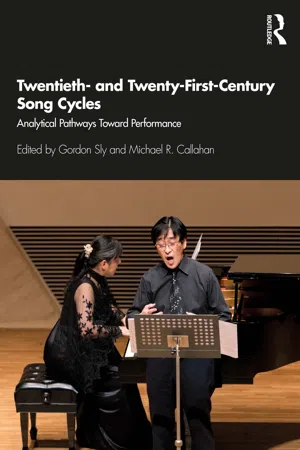
Twentieth- and Twenty-First-Century Song Cycles
Analytical Pathways Toward Performance
- 280 pages
- English
- ePUB (mobile friendly)
- Available on iOS & Android
Twentieth- and Twenty-First-Century Song Cycles
Analytical Pathways Toward Performance
About this book
Twentieth- and Twenty-First-Century Song Cycles: Analytical Pathways Toward Performance presents analyses of fourteen song cycles composed after the turn of the twentieth century, with a focus on offering ways into the musical and poetic structure of each cycle to performers, scholars, and students alike. Ranging from familiar works of twentieth-century music by composers such as Schoenberg, Britten, Poulenc, and Shostakovich to lesser-known works by Van Wyk, Sviridov, Wheeler, and Sánchez, this collection of essays captures the diversity of the song cycle repertoire in contemporary classical music. The contributors bring their own analytical perspectives and methods, considering musical structures, the composers' selection of texts, how poetic narratives are expressed, and historical context.
Informed by music history, music theory, and performance, Twentieth- and Twenty-First-Century Song Cycles offers an essential guide into the contemporary art-music song cycle for performers, scholars, students, and anyone seeking to understand this unique genre.
Frequently asked questions
- Essential is ideal for learners and professionals who enjoy exploring a wide range of subjects. Access the Essential Library with 800,000+ trusted titles and best-sellers across business, personal growth, and the humanities. Includes unlimited reading time and Standard Read Aloud voice.
- Complete: Perfect for advanced learners and researchers needing full, unrestricted access. Unlock 1.4M+ books across hundreds of subjects, including academic and specialized titles. The Complete Plan also includes advanced features like Premium Read Aloud and Research Assistant.
Please note we cannot support devices running on iOS 13 and Android 7 or earlier. Learn more about using the app.
Information
1
“As if with lightning bolts”
The Ombra and Tempesta in Schoenberg’s Das Buch der hängenden Gärten1
Introduction
Topical analysis
Defining the Ombra and Tempesta
| Ombra | Tempesta | |
|---|---|---|
General | High style, sombre, sustained | Agitated, declamatory, stormy |
Tempo | Slow or moderate | Fast |
Tonality | Flat keys (especially minor keys); occasionally... |
Table of contents
- Cover
- Half Title
- Title Page
- Copyright Page
- Dedication
- Table of Contents
- Introduction
- 1 “As if with lightning bolts”: The Ombra and Tempesta in Schoenberg’s Das Buch der hängenden Gärten
- 2 Georgy Sviridov’s Pushkin Romances: Approaches to Interpretation
- 3 Poetry, Voice, and Resistance in Poulenc’s Tel jour telle nuit
- 4 Guilt, Deliberation, Affirmation: Britten’s The Holy Sonnets of John Donne as Catharsis
- 5 Arnold van Wyk’s Van Liefde en Verlatenheid (“Of Love and Forsakenness”): Love and Others in 1950s South Africa
- 6 The Queer Context and Composition of Samuel Barber’s Despite and Still
- 7 Four Verses of Captain Lebyadkin: Nihilism and Transcendence in Late Shostakovich
- 8 Perceiving Imaginative and Intellectual Oscillation in George Crumb’s Apparition
- 9 Modern and Sentimental Voices in Scott Wheeler’s Wasting the Night
- 10 “Let Me Count the Ways”: Nostalgia and Repetition in Libby Larsen’s Sonnets from the Portuguese
- 11 Climbing the Mountain: Thoughts on Robert Morris’s Cold Mountain Songs
- 12 Portrayals of Incongruity in William Bolcom and Sandra Seaton’s From the Diary of Sally Hemings
- 13 Longing for a Fragment: Sappho as a Figure of Hope in Paul Sánchez’s ὁδοιπορία
- 14 There and Then, Here and Now: Higdon’s Civil Words
- Notes on Contributors
- Index